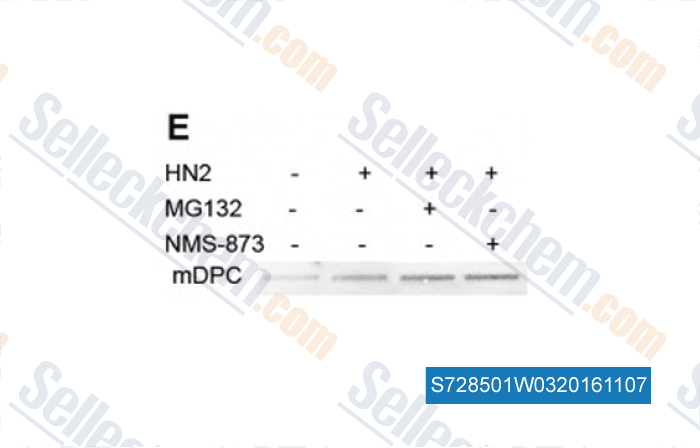|
How to Cite 1. For In-Text Citation (Materials & Methods): 2. For Key Resources Table: |
||
|
Toll Free: (877) 796-6397 -- USA and Canada only -- |
Fax: +1-832-582-8590 Orders: +1-832-582-8158 |
Tech Support: +1-832-582-8158 Ext:3 Please provide your Order Number in the email. We strive to reply to |
Technical Data
| Formula | C27H28N4O3S2 |
||||||
| Molecular Weight | 520.67 | CAS No. | 1418013-75-8 | ||||
| Solubility (25°C)* | In vitro | DMSO | 100 mg/mL (192.06 mM) | ||||
| Water | Insoluble | ||||||
| Ethanol | Insoluble | ||||||
| In vivo (Add solvents to the product individually and in order) |
|
||||||
|
* <1 mg/ml means slightly soluble or insoluble. * Please note that Selleck tests the solubility of all compounds in-house, and the actual solubility may differ slightly from published values. This is normal and is due to slight batch-to-batch variations. * Room temperature shipping (Stability testing shows this product can be shipped without any cooling measures.) |
|||||||
Preparing Stock Solutions
Biological Activity
| Description | NMS-873 is an allosteric and specific p97 inhibitor with IC50 of 30 nM that demonstrates potent selectivity for VCP/p97 compared to a panel of other AAA ATPases, Hsp90, and 53 additional analyzed kinases (IC50s >10 μM). | ||
|---|---|---|---|
| Targets |
|
||
| In vitro | NMS-873 reduces p97 sensitivity to trypsin digestion, preventing degradation of the linker-D2 domain. This compound, as a p97 inhibitor, produces antiproliferative activity in a variety of hematological and solid tumor lines. The mechanism study indicates that this chemical activates the unfolded protein response, interfers with autophagy and thus induces cancer cell death. [1] | ||
| Features | The most potent and specific p97 inhibitor described to date. |
Protocol (from reference)
| Kinase Assay: |
|
|---|---|
| Cell Assay: |
|
References
|
Customer Product Validation

-
, , Toxicol Appl Pharmacol, 2016, 305:267-73.
Selleck's NMS-873 Has Been Cited by 55 Publications
| Targeting site-specific N-glycosylated B7H3 induces potent antitumor immunity [ Nat Commun, 2025, 16(1):3546] | PubMed: 40229277 |
| Curcumin Induces Homologous Recombination Deficiency by BRCA2 Degradation in Breast Cancer and Normal Cells [ Cancers (Basel), 2025, 17(13)2109] | PubMed: 40647408 |
| The Fanconi anemia pathway induces chromothripsis and ecDNA-driven cancer drug resistance [ Cell, 2024, 187(21):6055-6070.e22] | PubMed: 39181133 |
| Co-opting templated aggregation to degrade pathogenic tau assemblies and improve motor function [ Cell, 2024, 187(21):5967-5980.e17] | PubMed: 39276772 |
| Transcription-coupled DNA-protein crosslink repair by CSB and CRL4CSA-mediated degradation [ Nat Cell Biol, 2024, 10.1038/s41556-024-01394-y] | PubMed: 38600236 |
| Sugar-mediated non-canonical ubiquitination impairs Nrf1/NFE2L1 activation [ Mol Cell, 2024, 84(16):3115-3127.e11] | PubMed: 39116872 |
| Reactive oxygen species control protein degradation at the mitochondrial import gate [ Mol Cell, 2024, 84(23):4612-4628.e13] | PubMed: 39642856 |
| Differential processing of RNA polymerase II at DNA damage correlates with transcription-coupled repair syndrome severity [ Nucleic Acids Res, 2024, gkae618] | PubMed: 39021334 |
| The protein segregase VCP/p97 promotes host antifungal defense via regulation of SYK activation [ PLoS Pathog, 2024, 20(10):e1012674] | PubMed: 39471181 |
| Inhibition of proteolytic and ATPase activities of the proteasome by the BTK inhibitor CGI-1746 [ iScience, 2024, 27(11):110961] | PubMed: 39759071 |
RETURN POLICY
Selleck Chemical’s Unconditional Return Policy ensures a smooth online shopping experience for our customers. If you are in any way unsatisfied with your purchase, you may return any item(s) within 7 days of receiving it. In the event of product quality issues, either protocol related or product related problems, you may return any item(s) within 365 days from the original purchase date. Please follow the instructions below when returning products.
SHIPPING AND STORAGE
Selleck products are transported at room temperature. If you receive the product at room temperature, please rest assured, the Selleck Quality Inspection Department has conducted experiments to verify that the normal temperature placement of one month will not affect the biological activity of powder products. After collecting, please store the product according to the requirements described in the datasheet. Most Selleck products are stable under the recommended conditions.
NOT FOR HUMAN, VETERINARY DIAGNOSTIC OR THERAPEUTIC USE.
